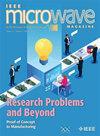寻找地外智能 2024 年 [微波冲浪]
IF 2.6
3区 计算机科学
Q2 ENGINEERING, ELECTRICAL & ELECTRONIC
引用次数: 0
摘要
本专栏的老读者一定还记得我长期以来对地外智慧科学探索(SETI)的痴迷。去年,我曾写过一篇关于美国天体物理学家弗兰克-德雷克(Frank Drake,1930-2022 年)的文章,他于 1960 年启动了 "奥兹玛计划"[2],其同名的德雷克方程[3]被用来估算银河系中可观测文明的数量。最近,我浏览了新出版的一批专门介绍 SETI 的书籍。其中包括《星际》(Interstellar):哈佛大学天文学家阿维-勒布(Avi Loeb)所著的《寻找地外生命和我们在恒星中的未来》[1];康奈尔大学卡尔-萨根研究所所长丽莎-卡尔滕格尔(Lisa Kaltenegger)所著的《外星地球》[4];以及罗切斯特大学物理学家亚当-弗兰克(Adam Frank)所著的《外星人小书》[5]。即使只是粗略地浏览一下这些书,也能清楚地看到一点。科学家们不仅超越了德雷克最初提出的寻找 "其他智慧文明发出的无线电波"[2]的设想,而且当前的 SETI 讨论还使用了许多公众不熟悉的术语。下面是其中的几个术语,让您了解更多信息。本文章由计算机程序翻译,如有差异,请以英文原文为准。
The Search for Extraterrestrial Intelligence 2024 [Microwave Surfing]
Regular readers of the column will recall my long-standing fascination with the scientific search for extraterrestrial intelligence (SETI). Last year, I wrote about the American astrophysicist Frank Drake (1930–2022), who kickstarted SETI in 1960 with his Project Ozma [2] and whose eponymous Drake equation [3] has been used to estimate the number of observable civilizations in our galaxy. Recently, I browsed through a new crop of books devoted to SETI. They included Interstellar: The Search for Extraterrestrial Life and Our Future in the Stars [1] by the Harvard astronomer Avi Loeb; Alien Earths [4] by Lisa Kaltenegger, the director of the Carl Sagan Institute at Cornell; and The Little Book of Aliens [5] by the physicist Adam Frank of the University of Rochester. Even a cursory perusal of these books makes one thing very clear. Not only are scientists going beyond Drake’s original vision of searching for “radio waves sent forth by other intelligent civilizations” [2]
, but the current SETI discourse also employs many terms unfamiliar to the wider public. Here are a few of them to bring you up to speed.
求助全文
通过发布文献求助,成功后即可免费获取论文全文。
去求助
来源期刊

IEEE Microwave Magazine
工程技术-电信学
CiteScore
3.90
自引率
5.60%
发文量
347
审稿时长
6-12 weeks
期刊介绍:
IEEE Microwave Magazine includes the current newsletter contents, including the President''s message, committee reports, and conference and meeting schedules and reports, of the IEEE Microwave Theory and Techniques Society. The magazine also publishes reviewed Tutorial and Application articles as well as book reviews and regular columns.
 求助内容:
求助内容: 应助结果提醒方式:
应助结果提醒方式:


